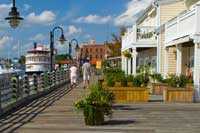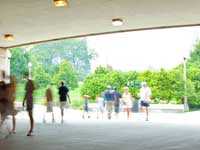Training Course Leads to Improved Outdoor Space for Physical Activity
April 2013
 |
|
Improving Walkability
Recommendations from PAPH course participants and community members helped to improve the walkability of history areas of Bluffton, South Carolina. |
Since 1996, the University of South Carolina Prevention Research Center (PRC) has offered its Physical Activity and Public Health (PAPH) course to public health practitioners from state and local health departments and postgraduate researchers across the United States. The course aims to enhance professional growth of practitioners to put into action public health research in exercise science by teaching the most up-to-date physical activity science. The course is divided into two sections — an 8-day course for postgraduate researchers and a 6-day course for practitioners. One of the unique features of the PAPH course is its capstone project that takes place in either the community of Bluffton, South Carolina, or in Park City, Utah. In general, the course alternates between locations. The capstone is an experiential learning component where the practitioners use the lessons they have learned to help the community solve challenges.
Before the PAPH course starts, the course faculty engages the community of Bluffton or Park City to develop potential projects. Through this engagement the course has created strong working relationships with partners such as Bluffton’s Office of Planning and Environmental Sustainability and Park City’s County Health Department. During the course, the community members and practitioners spend a day developing recommendations together that could improve physical activity in the community. Their recommendations, grounded in evidence-based practices covered in the course and built on existing strengths and resources identified by the community, are presented at a public forum.
Many of the recommendations have been used to improve the walkability, safety, and connectivity between schools, parks, and shopping areas in Bluffton and Park City. For example, in Bluffton in 2001, the practitioners and community members recommended that the city purchase the historic Bluffton Oyster Company and the surrounding area to turn the landmark site into a park. In 2006, a community trust bought the landmark site and made it a walkable area that now connects to the downtown historic district. In 2006 in Park City, Utah, practitioners and community members recommended that an underpass be built in downtown to link a low-income housing complex to working and shopping areas across the street. The underpass allows bikers and pedestrians to safely avoid busy street crossings. In 2011, the underpass was built as part of a $15 million referendum to improve walking, biking, and access to parks.
 |
|
Underpasses Give Pedestrians Safe Routes
Helping pedestrians avoid busy streets by creating underpasses helps to improve safety and walkability. |
The collaborative relationships built between the South Carolina PRC, health departments, and local governments of Bluffton and Park City provided a forum for experiential learning that had a positive effect on the built environment. The PAPH’s capstone experience serves as an exemplary model and inspired other state, national, and international government agencies to create similarly structured courses.
Applications are now being accepted for the 2013 PAPH course and are due by May 15, 2013. More information can be found on the PAPH's Web site.
- Page last reviewed: April 5, 2013
- Page last updated: May 5, 2016
- Content source:


 ShareCompartir
ShareCompartir